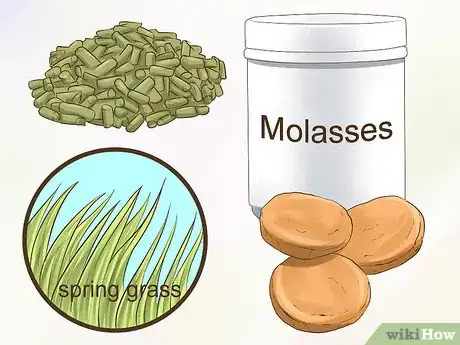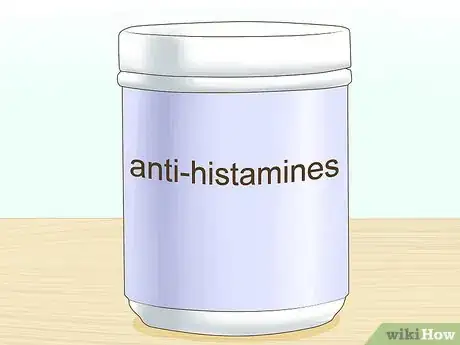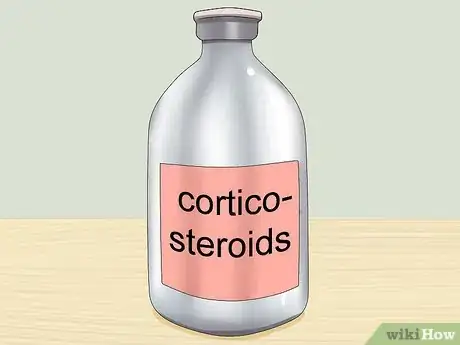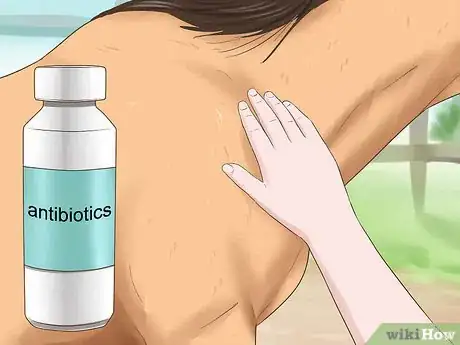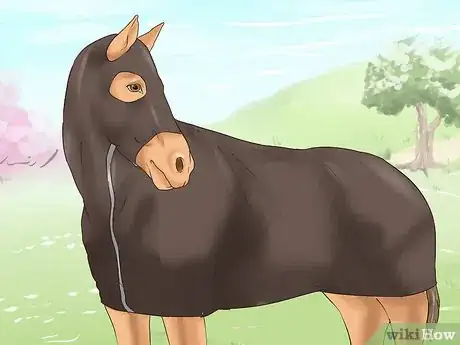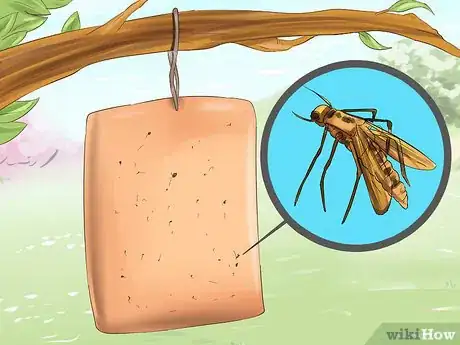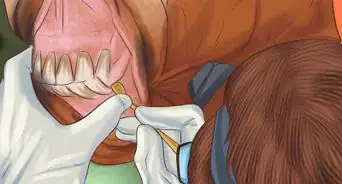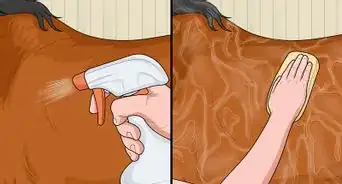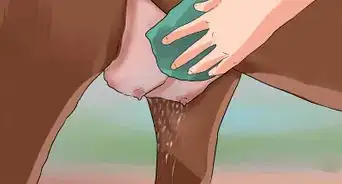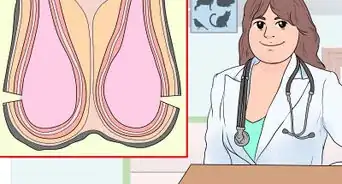This article was co-authored by Ryan Corrigan, LVT, VTS-EVN. Ryan Corrigan is a Licensed Veterinary Technician in California. She received her Bachelor of Science in Veterinary Technology from Purdue University in 2010. She is also a Member of the Academy of Equine Veterinary Nursing Technicians since 2011.
There are 7 references cited in this article, which can be found at the bottom of the page.
This article has been viewed 39,495 times.
Sweet itch is a condition in horses caused by an allergic reaction to the bites of culicoides (or midges). It is sometimes called Queensland Itch, Seasonal Recurrent Dermatitis, or Summer Itch. The treatment of sweet itch involves the prevention of future midge bites and an effort to soothe the itch so that existing lesions can heal. Additionally, it may help to quell your horse’s immune response (by way of anti-histamines or cortico-steroids). You will likely use a mix of the following three methods to effectively treat sweet itch in your horse: administering natural remedies, consulting your vet about medication options, and altering your horse’s environment.
Steps
Administering Natural Remedies
-
1Add flaxseed to your horse's diet. Some research suggests that adding flaxseed (also called linseed) to your horse’s diet can quiet the allergic response. Add a bit of crushed or milled flaxseed to your horse’s food.[1]
- You should discuss this with your veterinarian or herbalist before beginning supplementation.
- You will want to provide 1 lb. (0.45 kg) of flaxseed per every 1,000 lbs. (454 kg) of your animal’s weight, per day.
-
2Apply neem oil. Neem oil is an essential oil extracted from the neem tree. It has a solid consistency (when cold) and a strong smell. It acts as an excellent natural insecticide. Warm the neem oil in your palms and apply to your horse’s neck. Leave this on for at least one hour, and shampoo off.[2]
- You can double your efforts by using a natural insecticide shampoo.
Advertisement -
3Cut “sweet things” from your horse’s diet. Sweet foods—molasses, sugary feeds, some spring grasses, and sweet treats—have been shown to exacerbate the conditions of sweet itch. (Some believe this is where the name Sweet Itch is derived). These foods should be strictly avoided in your horse’s diet.[3]
-
4Apply natural remedies to the skin. In order for your horse’s lesions to heal, you must attempt to quell the itch. Apply aloe, lavender oil, or wild germanium oil directly to your horse’s skin, or dilute essential oils in a carrier oil (such as coconut oil).[4]
- Avoid applying essential oil to broken skin.
-
5Give the horse apple cider vinegar or garlic. You might also be able to help prevent sweet itch by feeding your horse certain foods. The idea is to change the smell of the horse’s sweat so that midges aren’t attracted – and won’t bite.[5]
- You might try mixing adding apple cider vinegar to the horse’s feed, for instance. Also try feeding the horse two tablespoons of garlic powder twice a day.
Consulting Your Vet About Medication
-
1Provide anti-histamines. Anti-histamines created for humans have been shown to reduce symptoms of Sweet Itch in horses. However, this can be cost-prohibitive due to the large doses needed for a horse.[6]
- Discuss this option with your veterinarian to determine the proper dose for your animal.
-
2Administer cortico-steroids. Cortico-steroids (administered by your vet) have been shown to be extremely effective at suppressing the immune response that causes Sweet Itch. This relieves the itch and helps your horse’s lesions to heal.[7]
- The use of steroids can make horses more susceptible to Laminitis.
- As such, this method should be explored only in severe cases, or when other methods have not worked.
-
3Explore “immunotherapy.” In essence, Sweet Itch is caused by an incorrect “over-reaction” of the immune system. A company called BioEos has created a capsule-based treatment that helps to correct the immune response. This capsule has been shown to cause a 50% improvement in 70% of horses with Sweet Itch.[8]
- Discuss this option with your vet.
-
4Use antibiotics. Sweet Itch can induce violent scratching responses in your animal, leading to painful lesions and wounds. If the Sweet Itch lesions have created an infection, antibiotics may be needed to treat the problem, and help quell the itch.[9]
- Once again, this is an issue to discuss with your vet.
Altering Your Horse’s Environment
-
1Stable your horse at midge feeding time. Dawn and dusk are the times of day when midges do their feeding. You can reduce your horse’s exposure to these biting insects by stabling them during these times, especially from about 4pm to 8am. Prevent midges from entering your stable by closing any doors and windows and/or ensuring screens are in place.[10] [11]
-
2Use fans. The use of fans inside your stable is another great way to naturally repel the insects and help keep your stable midge-free. Midges can’t fly or land in strong breezes – anything over 5 mph is too much for them. It’s best to direct fans to the locations on your horse where midges tend to populate, such as around the neck and tail. This may require several fans.[12] [13]
-
3Prevent midges from colonizing your stable. When you have rotting vegetation, manure, or standing water in or near your stable, you are creating an ideal environment for midge infestation.[14] You can reverse the situation by:
- Remove any rotting vegetation, such as leaves or hay.
- Get rid of any puddles or standing water nearby.
- Dispose of any horse droppings in your yard.
-
4Outfit your horse with barriers. “Barriers” may include sweet itch rugs, blankets, masks, and hoods. These garments protect your horse from midges (preventing further bites) while also preventing your horse from scratching and causing damage (or even infection). Sweet itch barriers are an excellent preventative measure, and they can also enable your horse to heal.[15]
- It is important to keep rugs, blankets, and hoods clean and free of midges.
- If possible, it is best to have two of each barrier method you choose, so that you can use one while the other is being washed.
-
5Use traps. You may be able to help control the midge population in and around your stable by way of regular fly or insect traps. This may include things like glue strips, insect zappers, and/or catch and release traps. Install any of these devices outside or inside your horse stable to help keep the midges away from your horse.[16]
-
6Turn your horse out on a hilltop pasture, if possible. Midges breed in low-lying, wet areas such as marshy, boggy fields and pastures. Many horses with sweet itch can be controlled by turning them out onto hilltop pastures – away from these breeding grounds.
- Hilltops pastures are also more exposed to wind, which will further repel midges from your animal.
References
- ↑ https://www.ncbi.nlm.nih.gov/pmc/articles/PMC227015/
- ↑ http://www.sweet-itch.org/prevention.htm
- ↑ http://www.sweet-itch.org/prevention.htm
- ↑ http://www.sweet-itch.org/treatment.htm
- ↑ https://equusmagazine.com/uncategorized/eqsweetitc378
- ↑ http://www.sweet-itch.org/treatment.htm
- ↑ https://www.fginsight.com/vip/vip/how-to-handle-a-sweet-itch-attack-492
- ↑ https://www.fginsight.com/vip/vip/how-to-handle-a-sweet-itch-attack-492
- ↑ https://www.fginsight.com/vip/vip/how-to-handle-a-sweet-itch-attack-492
- ↑ http://www.sweet-itch.org/prevention.htm
- ↑ http://www.horseandhound.co.uk/features/sweet-itch-in-horses-471923
- ↑ http://www.horseandhound.co.uk/features/sweet-itch-in-horses-471923
- ↑ http://www.sweet-itch.org/prevention.htm
- ↑ http://www.sweet-itch.org/prevention.htm
- ↑ http://www.sweet-itch.org/prevention.htm
- ↑ https://www.southernstates.com/articles/horse-fly-control-tips.aspx
About This Article
To treat sweet itch in horses, start by adding crushed or milled flaxseed to your horse's food, which can sometimes soothe a mild allergic response. Measure out 1 pound of flaxseed for every 1,000 pounds of your animal’s weight and mix it into your horse's food each day. Applying a handful of neem oil to your horse's neck can also be helpful, but don't forget to shampoo it out after about an hour! If your horse's lesions look infected, it's best to see a veterinarian, who will probably recommend a course of antibiotics to knock out the infection. For tips on environmental changes you can make that might help, read on!


